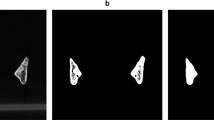Abstract
Orthodontists are interested in finding a set of standard arch forms for clinical orthodontic practice. In this paper, we propose a functional clustering method for the dental arches based on a mixture of U-shaped curves. We decide the number of clusters (equivalently, mixture components) using the Bayesian information criterion and the jump criterion based on a given distortion function. We apply our method to clustering the dental arch data from the nationwide standard occlusion study conducted in Korea from 1997 to 2005. The data are composed of dental arches of 306 subjects with normal occlusion selected from 15,836 young adults. We also provide the comparison of the proposed method to other existing methods.
Similar content being viewed by others
References
Angle, E. H. (1899). Classification of malocclusion. Dental Cosmos, 41, 248–264.
Begole, E. (1980). Application of the cubic spline function in the description of dental arch form. Journal of Dental Research, 59, 1549–1556.
Biggerstaff, R. H. (1972). Three variations in dental arch form estimated by a quadratic equation. Journal of Dental Research, 51, 1509.
Bozdogan, H., & Sclove, S. L. (1984). Multi-sample cluster analysis using Akaike’s information criterion. Annals of the Institute of Statistical Mathematics, 36, 163–180.
Burdi, A. R. (1968). Morphogenesis of mandibular dental arch shape in human embryos. Journal of Dental Research, 47, 50–58.
Camporesi, M., Franchi, L., Baccetti, T., & Antonini, A. (2006). Thin-plate spline analysis of arch form in a Southern European popoulation with an ideal natrual occlusion. European Journal of Orthodontics, 28, 135–140.
Celeux, G., & Soromenho, G. (1996). An entropy criterion for assessing the number of clusters in a mixture model. Journal of Classification, 13, 195–212.
Currier, J. (1969). A computerized geometric analysis of human dental arch form. American Journal of Orthodontics, 56, 164–179.
Dasgupta, A., & Raftery, A. E. (1998). Detecting features in spatial point processes with clutter via model-based clustering. Journal of the American Statistical Association, 93, 294–302.
Dryden, I. L., & Mardia, K. V. (1998). Statistical shape analysis. John Wiley & Sons.
Fraley, C., & Raftery, A. E. (1998). How many clusters? Which clustering method? Answers via model-based cluster analysis. The Computer Journal, 41, 578–588.
Gu, Q., Shibata, T., Fujita, K., & Takada, K. (2002). Application of vector quantization algorithm to dental arch classification in orthodontics practice. In Proceedings of IEEE world automation congress (pp. 279–285).
Hechter, F. (1978). Symmetry and dental arch form of orthodontically treated patients. Dental Journal, 44, 173–184.
Henrikson, J., Persson, M., & Thilander, B. (2001). Long-term stability of dental arch form in normal occlusion from 13 to 31 years of age. European Journal of Orthodontics, 23, 51–61.
James, G. M., & Sugar, C. A. (2003). Clustering for sparsely sampled functional data. Journal of the American Statistical Association, 98, 397–408.
Lee, S. J., Lee, S., Lim, J., Park, H. J., & Wheeler, T. (2011). Method to classify human dental arch form. American Journal of Orthodontics and Dentofacial Orthopedics, 140(1), 87–96.
Lim, J., Lee, S., Park, H. J., Lee, K. E., & Lee, S. J. (2014). Bootstrap method to evaluate tightness of clusters with application to the Korean standard occlusion study. Journal of Statistical Computation and Simulation, 84, 360–372.
MacConail, M. A., & Scher, E. A. (1949). Ideal form of the human dental arcade with some prosthetic applications. Journal of Dental Research, 69, 285–302.
Mutinelli, S., Cozzani, M., Manfredi, M., Bee, M., & Siciliani, G. (2008). Dental arch changes following rapid maxillary expansion. European Journal of Orthodontics, 30, 469–476.
Noroozi, H., Nik, T., & Saeeda, R. (2001). The dental arch form revisited. The Angle Orthodontist, 71, 386–389.
Pepe, S. (1975). Polynomial and catenary curve fits to human dental arches. Journal of Dental Research, 36, 996–1003.
Ramsay, J. (1988). Monotone regression splines in action. Statistical Science, 3, 425–441.
Ronay, V., Miner, R., Will, L., & Arai, K. (2008). Mandibular arch form: the relationship between dental and basal anatomy. American Journal of Orthodontics and Dentofacial Orthopedics, 134, 430–438.
Sampson, P. (1981). Dental arch shape: A statistical analysis using conic sections. American Journal of Orthodontics, 79, 535–548.
Schoenemann, P. H., & Carroll, R. (1970). Fitting one matrix to another under choice of a central dilation and a rigid motion. Psychometrika, 35(2), 245–255.
Scott, J. H. (1957). The shape of dental arches. Journal of Dental Research, 36, 996–1003.
Sugar, C. A., & James, G. M. (2003). Finding the number of clusters in a dataset: An information-theoretic approach. Journal of the American Statistical Association, 98, 750–762.
Taner, T., Ciger, S., El, H., Germec, D., & Es, A. (2004). Evaluation of dental arch width and form changes after orthodontic treatment and retention with a new computerized method. American Journal of Orthodontics and Dentofacial Orthopedics, 126, 464–475.
Trivino, T., Siqueira, D., & Scanavini, M. (2008). A new concept of mandibular dental arch forms with normal occlusion. American Journal of Orthodontics and Dentofacial Orthopedics, 133(1), 10.e15–10.e22.
Valenzuela, A., Pardo, M., & Yezioro, S. (2002). Description of dental arch form using the Fourier series. The International Journal of Adult Orthodontics and Orthognathic Surgery, 17, 59–65.
Yun, Y. K., Kook, Y., Kim, S., Mo, S., Cha, K., Kim, J., et al. (2004). Mandibular clinical arch forms in Koreans with normal occlusions. Korean Journal of Orthodontics, 34, 481–487.
Author information
Authors and Affiliations
Corresponding author
Electronic supplementary material
Rights and permissions
About this article
Cite this article
Lee, K.E., Lim, J., Won, JH. et al. Finding standard dental arch forms from a nationwide standard occlusion study using a Gaussian functional mixture model. J. Korean Stat. Soc. 44, 477–489 (2015). https://doi.org/10.1016/j.jkss.2015.04.003
Received:
Accepted:
Published:
Issue Date:
DOI: https://doi.org/10.1016/j.jkss.2015.04.003




